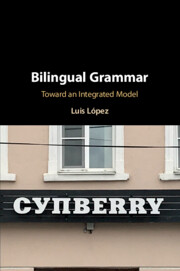Refine search
Actions for selected content:
6584 results in Grammar and Syntax
Appendix
-
- Book:
- Syntactic Constructions in English
- Print publication:
- 21 May 2020, pp 320-336
-
- Chapter
- Export citation
Contents
-
- Book:
- Syntactic Constructions in English
- Print publication:
- 21 May 2020, pp v-x
-
- Chapter
- Export citation
8 - Auxiliary and Related Constructions
-
- Book:
- Syntactic Constructions in English
- Print publication:
- 21 May 2020, pp 186-215
-
- Chapter
- Export citation
1 - What Is a Theory of English Syntax About?
-
- Book:
- Syntactic Constructions in English
- Print publication:
- 21 May 2020, pp 1-18
-
- Chapter
- Export citation
Index
-
- Book:
- Syntactic Constructions in English
- Print publication:
- 21 May 2020, pp 352-356
-
- Chapter
- Export citation
9 - Passive Constructions
-
- Book:
- Syntactic Constructions in English
- Print publication:
- 21 May 2020, pp 216-236
-
- Chapter
- Export citation

Bilingual Grammar
- Toward an Integrated Model
-
- Published online:
- 02 May 2020
- Print publication:
- 30 April 2020
7 - Lexical Questions: What Do You Learn When You Learn a Word?
-
- Book:
- Bilingual Grammar
- Published online:
- 02 May 2020
- Print publication:
- 30 April 2020, pp 130-145
-
- Chapter
- Export citation
Acknowledgments
-
- Book:
- Bilingual Grammar
- Published online:
- 02 May 2020
- Print publication:
- 30 April 2020, pp viii-viii
-
- Chapter
- Export citation
Copyright page
-
- Book:
- Bilingual Grammar
- Published online:
- 02 May 2020
- Print publication:
- 30 April 2020, pp iv-iv
-
- Chapter
- Export citation
Appendix A: Restrictions on Code-Switching
-
- Book:
- Bilingual Grammar
- Published online:
- 02 May 2020
- Print publication:
- 30 April 2020, pp 193-203
-
- Chapter
- Export citation
6 - 1PF in MDM
-
- Book:
- Bilingual Grammar
- Published online:
- 02 May 2020
- Print publication:
- 30 April 2020, pp 116-129
-
- Chapter
- Export citation
5 - Building the Case for 1Lex: Gender in Code-Switching
-
- Book:
- Bilingual Grammar
- Published online:
- 02 May 2020
- Print publication:
- 30 April 2020, pp 76-115
-
- Chapter
- Export citation
9 - Convergent and Divergent Paths
-
- Book:
- Bilingual Grammar
- Published online:
- 02 May 2020
- Print publication:
- 30 April 2020, pp 165-184
-
- Chapter
- Export citation
1 - Introduction: Motivating a Unified Linguistic System
-
- Book:
- Bilingual Grammar
- Published online:
- 02 May 2020
- Print publication:
- 30 April 2020, pp 1-11
-
- Chapter
- Export citation
Figures
-
- Book:
- Bilingual Grammar
- Published online:
- 02 May 2020
- Print publication:
- 30 April 2020, pp vii-vii
-
- Chapter
- Export citation
References
-
- Book:
- Bilingual Grammar
- Published online:
- 02 May 2020
- Print publication:
- 30 April 2020, pp 211-224
-
- Chapter
- Export citation
Index
-
- Book:
- Bilingual Grammar
- Published online:
- 02 May 2020
- Print publication:
- 30 April 2020, pp 225-230
-
- Chapter
- Export citation
10 - General Conclusions
-
- Book:
- Bilingual Grammar
- Published online:
- 02 May 2020
- Print publication:
- 30 April 2020, pp 185-192
-
- Chapter
- Export citation
Contents
-
- Book:
- Bilingual Grammar
- Published online:
- 02 May 2020
- Print publication:
- 30 April 2020, pp v-vi
-
- Chapter
- Export citation
